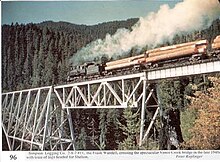| Revision as of 05:56, 7 September 2009 editBobrayner (talk | contribs)Autopatrolled, Extended confirmed users, Pending changes reviewers, Rollbackers53,710 editsm Fixed typo, feet -> feat← Previous edit | Revision as of 06:24, 7 September 2009 edit undoWavelength (talk | contribs)Extended confirmed users, Pending changes reviewers179,502 edits →Railroad: removing hyphen: → "mostly abandoned"—see WP:HYPHEN, sub-subsection 3, point 4 (WP:DYK)Next edit → | ||
| Line 26: | Line 26: | ||
| ===Railroad=== | ===Railroad=== | ||
| The Simpson Company is also notable for the construction and operations of its own logging ] known as the ''Simpson Railroad''. It is one of the last logging railroad operations in the continental United States<ref>{{cite web|url=http://news.google.com/newspapers?id=BCcWAAAAIBAJ&sjid=lxUEAAAAIBAJ&dq=simpson%20railroad&pg=2151%2C2789792|title=Heavy Lifting|accessdate=2009-09-01|date=2007-03-22|publisher=Shelton-Mason County Journal}}</ref> and dates back some 120 years. The railroad was once extensive and branched out into several hundred miles of forestland in the ] but is now limited to less than fifteen miles of operational track. The rail lines was used not only to transport lumber but also as a transportation network to remote logging camps and towns. Construction of the railroad line was an engineering feat as demonstrated by the large and complex bridges built to span gorges as well as the mountainous terrain the railroad traveled through. Perhaps the most notable landmarks of the now mostly |
The Simpson Company is also notable for the construction and operations of its own logging ] known as the ''Simpson Railroad''. It is one of the last logging railroad operations in the continental United States<ref>{{cite web|url=http://news.google.com/newspapers?id=BCcWAAAAIBAJ&sjid=lxUEAAAAIBAJ&dq=simpson%20railroad&pg=2151%2C2789792|title=Heavy Lifting|accessdate=2009-09-01|date=2007-03-22|publisher=Shelton-Mason County Journal}}</ref> and dates back some 120 years. The railroad was once extensive and branched out into several hundred miles of forestland in the ] but is now limited to less than fifteen miles of operational track. The rail lines was used not only to transport lumber but also as a transportation network to remote logging camps and towns. Construction of the railroad line was an engineering feat as demonstrated by the large and complex bridges built to span gorges as well as the mountainous terrain the railroad traveled through. Perhaps the most notable landmarks of the now mostly abandoned line are the Vance Creek Bridge and the ]. Both bridges were built in 1929 and in use until the 1950s when the line was abandoned. The bridges still stand with the High Steel Bridge still in use as a ]. The High Steel Bridge also has the distinction of being one of the tallest rail bridges in the United States and has been listed in the ].<ref name="nris">{{cite web|url=http://www.nr.nps.gov/|title=National Register Information System|date=2007-01-23|work=National Register of Historic Places|publisher=National Park Service}}</ref> | ||
| ==References== | ==References== | ||
Revision as of 06:24, 7 September 2009

The Simpson Investment Company is a Pacific Northwest based company that specializes in production and manufacture of forest products. Originally founded as a logging company in 1890 by Sol Simpson, the company currently functions as a holding company for its three subsidiaries who deal with different sectors in the forestry industry. They are Simpson Lumber Company, the Simpson Door Company and the Simpson Tacoma Kraft Company. The Simpson Lumber Company conducts logging operations in Shelton, Washington and in South Carolina while the Simpson Door Company manufactures wood doors. The Simpson Tacoma Kraft Company produces pulpwood and linerbaord products. Simpson announced in 2008 that they will be entering the "green power" industry by building a new power plant at its Tacoma tideflats mill that will generate power via the burning of sawmill and other forest waste. In August 2009, construction of the power plant was complete and it currently generates 55 megawatts of power which is sold to Iberdrola Renovables and used by the Sacramento Municipal Utility District.
Company Divisions

The company was split in to two separate units in 2006. The Green Diamond Resource Company is a spinoff that was created to manage Simpson's forest lands. Both companies are owned by the same shareholders and as with the current subsidiaries, function as separate departments within a large company rather than as completely independent companies.
Railroad
The Simpson Company is also notable for the construction and operations of its own logging railroad known as the Simpson Railroad. It is one of the last logging railroad operations in the continental United States and dates back some 120 years. The railroad was once extensive and branched out into several hundred miles of forestland in the Olympic Peninsula but is now limited to less than fifteen miles of operational track. The rail lines was used not only to transport lumber but also as a transportation network to remote logging camps and towns. Construction of the railroad line was an engineering feat as demonstrated by the large and complex bridges built to span gorges as well as the mountainous terrain the railroad traveled through. Perhaps the most notable landmarks of the now mostly abandoned line are the Vance Creek Bridge and the High Steel Bridge. Both bridges were built in 1929 and in use until the 1950s when the line was abandoned. The bridges still stand with the High Steel Bridge still in use as a forest road. The High Steel Bridge also has the distinction of being one of the tallest rail bridges in the United States and has been listed in the National Register of Historic Places.
References
- ^ Chris Genna. "Simpson splits units but keeps focus". Puget Sound Business Journal. Retrieved 2009-08-31.
- John Gillie (2008-04-28). "Simpson Investment Co. will build power plant at Tacoma Tideflats mill". Tacoma News Tribune. Retrieved 2009-08-31.
- "New Tacoma biomass plant starts churning power". Puget Sound Business Journal. 2009-08-11. Retrieved 2009-09-06.
- "Heavy Lifting". Shelton-Mason County Journal. 2007-03-22. Retrieved 2009-09-01.
- "National Register Information System". National Register of Historic Places. National Park Service. 2007-01-23.